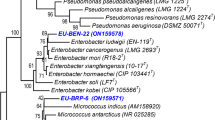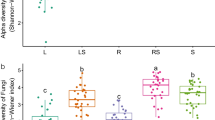Abstract
The essential oil produced by vetiver can vary in amount and composition depending on the bacterial community associated with its roots. Some of these bacteria could also promote plant growth by fixing nitrogen. This study aimed to analyze the diversity of diazotrophic bacteria tightly associated with roots of different vetiver genotypes. nifH-based PCR-denaturing gradient gel electrophoresis (DGGE) and clone libraries were used. DGGE profiles obtained from bulk and rhizosphere soils and root DNA amplified with nifH primers showed that samples from rhizosphere soil and root were separated at 68% similarity. Twelve bands were excised from the DGGE and sequenced. High similarity with nifH sequences of Bradyrhizobium sp., Pseudacidovorax sp. and Xanthobacter sp. was observed. Moreover, three nifH clone libraries were generated using polF/polR-primers from root DNA samples obtained from vetiver genotypes UFS-VET001, UFS-VET003 and UFS-VET004. In UFS-VET001, 24.2% of 95 clones were affiliated with sequences of Mesorhizobium loti while in UFS-VET003 41.5% of 89 clones were affiliated with Sphingomonas azotifigens, and in UFS-VET004 36.4% of 85 clones were affiliated with Klebsiella pneumoniae. The data obtained can be used to guide the isolation of diazotrophic bacteria, which may contribute to plant growth promotion and improvement of the production of essential oil in vetiver.


Similar content being viewed by others
References
Adams RP, Habte M, Park S, Dafforn MR (2004) Preliminary comparison of vetiver root essential oils from cleansed (bacteria- and fungus-free) versus non-cleansed (normal) vetiver plants. Biochem Syst Ecol 32:1137–1144
Altschul SF, Madden TL, Schaffer AA, Zhang J, Zhang Z, Miller W, Lipman DJ (1997) Gapped BLAST and PSI-BLAST: a new generation of protein database search programs. Nucleic Acids Res 25:3389–3402
Antiochia R, Campanella L, Ghezzi P, Movassaghi K (2007) The use of vetiver for remediation of heavy metal soil contamination. Anal Bioanal Chem 388:947–956
Arrigoni-Blank MF, Santos RB, Rosa YRS, Oliveira-Neta PM, Alves PB, Blank AF (2010). Agronomic and chemical characterization of vetiver accessions. 28th International Horticultural Congress. E-poster Sm08.237
Bhattacharjee RB, Singh A, Mukhopadhyay SN (2008) Use of nitrogen-fixing bacteria as biofertiliser for non-legumes: prospects and challenges. Appl Microbiol Biotechnol 80:199–209
Brandt R, Merkl N, Schultze-Kraft R, Infante C, Broll G (2006) Potential of vetiver (Vetiveria zizanioides (L.) Nash) for phytoremediation of petroleum hydrocarbon contaminated soils in Venezuela. Int J Phytoremediation 8:273–284
Champagnat P, Figueredo G, Chalchat JC, Carnat AP, Bessiere JM (2006) A study on the composition of commercial Vetiveria zizanioides oils from different geographical origins. J Essent Oil Res 18:416–422
Chelius MK, Triplett EW (2001) The diversity of archaea and bacteria in association with the roots of Zea mays L. Microb Ecol 41:252–263
Coelho MRR, de Vos M, Carneiro NP, Marriel IE, Paiva E, Seldin L (2008) Diversity of nifH gene pools in the rhizosphere of two cultivars of sorghum (Sorghum bicolor) treated with contrasting levels of nitrogen fertilizer. FEMS Microbiol Lett 279:15–22
Coelho MRR, Carneiro NP, Marriel IE, Seldin L (2009a) Molecular detection of nifH gene-containing Paenibacillus in the rhizosphere of sorghum (Sorghum bicolor) sown in Cerrado soil. Lett Appl Microbiol 48:611–617
Coelho MRR, Marriel IE, Jenkins SN, Lanyon CV, Seldin L, O’Donnell AG (2009b) Molecular detection and quantification of nifH gene sequences in the rhizosphere of sorghum (Sorghum bicolor) sown with two levels of nitrogen fertilizer. Appl Soil Ecol 42:48–53
Del Giudice L, Massardo DR, Pontieri P, Bertea CM, Mombello D, Carata E, Tredici SM, Talà A, Mucciarelli M, Groudeva VI, De Stefano M, Vigliotta G, Maffei ME, Alifano P (2008) The microbial community of Vetiver root and its involvement into essential oil biogenesis. Environ Microbiol 10:2824–2841
Demba Diallo M, Willems A, Vloemans N, Cousin S, Vandekerckhove TT, de Lajudie P, Neyra M, Vyverman W, Gillis M, Van der Gucht K (2004) Polymerase chain reaction denaturing gradient gel electrophoresis analysis of the N2-fixing bacterial diversity in soil under Acacia tortilis ssp. raddiana and Balanites aegyptiaca in the dryland part of Senegal. Environ Microbiol 6:400–415
Felsenstein J (1989) PHYLIP-phylogeny inference package (version 3.2). Cladistics 5:164–166
Hammer KA, Carson CF, Riley TV (1999) Antimicrobial activity of essential oils and other plant extracts. J Appl Microbiol 86:985–990
Hurek T, Handley LL, Reinhold-Hurek B, Piche Y (2002) Azoarcus grass endophytes contribute fixed nitrogen to the plant in an unculturable state. Mol Plant Microb Interact 15:233–242
Kennedy IR, Choudhury ATMA, Kecske’s ML (2004) Non-symbiotic bacterial diazotrophs in crop-farming systems: can their potential for plant growth promotion be better exploited? Soil Biol Biochem 36:1229–1244
Kim HJ, Chen F, Wang X, Chung HY, Jin Z (2005) Evaluation of antioxidant activity of vetiver (Vetiveria zizanioides L.) oil and identification of its antioxidant constituents. J Agric Food Chem 53:7691–7695
Knauth S, Hurek T, Brar D, Reinhold-Hurek B (2005) Influence of different Oryza cultivars on expression of nifH gene pools in roots of rice. Environ Microbiol 7:1725–1733
Lovell CR, Decker PV, Bagwell CE, Thompson S, Matsui GY (2008) Analysis of a diverse assemblage of diazotrophic bacteria from Spartina alterniflora using DGGE and clone library screening. J Microbiol Methods 73:160–171
Lugtenberg B, Kamilova F (2009) Plant-growth-promoting rhizobacteria. Annu Rev Microbiol 63:541–556
Maffei M (2002) Vetiveria: the genus Vetiveria. Taylor and Francis, London
Massardo DR, Senatore F, Alifano P, Del Giudice L, Pontieri P (2006) Vetiver oil production correlates with early root growth. Biochem Syst Ecol 34:376–382
Monteiro JM, Vollú RE, Coelho MRR, Alviano CS, Blank AF, Seldin L (2009) Comparison of the bacterial community and characterization of plant growth promoting rhizobacteria from different genotypes of Chrysopogon zizanioides (L.) Roberty (Vetiver) rhizospheres. J Microbiol 47:363–370
Peyron L (1989) Vetiver in perfumery. Quintessenza 13:4–161
Poly F, Ranjard L, Nazaret S, Gourbiere F, Monrozier LJ (2001) Comparison of nifH gene pools in soils and soil microenvironments with contrasting properties. Appl Environ Microbiol 67:2255–2262
Reis VM, Pereira W, Schultz N, Alves GC, Giori F, Urquiaga S, Baldani JI (2010) Development of bacterial inoculants for application on sugarcane and maize. Abstract of the 12th International Symposium on Biological Nitrogen Fixation with Non-Legumes, Buzios, Brazil, SV.02, p. 59
Ryan RP, Germaine K, Franks A, Ryan DJ, Dowling DN (2008) Bacterial endophytes: recent developments and applications. FEMS Microbiol Lett 278:1–9
Sambrook J, Fritsch EF, Maniatis T (1989) Molecular cloning: a laboratory manual. Cold Spring Harbor Laboratory Press, New York, N.Y., USA
Schloss PD, Handelsman J (2005) Introducing DOTUR, a computer program for defining operational taxonomic units and estimating species richness. Appl Environ Microbiol 71:1501–1506
Simonet P, Grosjean MC, Misra AK, Nazaret S, Cournoyer B, Normand P (1991) Frankia genus-specific characterization by polymerase chain reaction. Appl Environ Microbiol 57:3278–3286
Soares RA, Roesch LFW, Zantatta G, Camargo FAdO, Passaglia LPM (2006) Occurrence and distribution of nitrogen fixing bacteria community associated with oat (Avena sativa) assessed by molecular and microbiological techniques. Appl Soil Ecol 33:221–234
Tan Z, Hurek T, Reinhold-Hurek B (2003) Effect of N-fertilization, plant genotype and environmental conditions on nifH gene pools in roots of rice. Environ Microbiol 5:1009–1015
Thomas P, Soly TA (2009) Endophytic bacteria associated with growing shoot tips of banana (Musa sp.) cv. Grand Naine and the affinity of endophytes to the host. Microb Ecol 58:952–964
Thompson JD, Gibson TJ, Plewniak F, Jeanmougin F, Higging DG (1997) The CLUSTAL-X windows interface: flexible strategies for multiple sequence alignment aided by quality tools. Nucleic Acid Res 25:4876–4882
Ueda T, Suga Y, Yahiro N, Matsuguchi (1995) Remarkable N2- fixing bacterial diversity detected in rice roots by molecular evolutionary analysis of nifH gene sequences. J Bacteriol 177:1414–1417
Venieraki A, Dimou M, Pergalis P, Kefalogianni I, Chatzipavlidis I, Katinakis P (2010). The genetic diversity of culturable nitrogen-fixing bacteria in the rhizosphere of wheat. Microb Ecol. In press
Wartiainen I, Eriksson T, Zheng W, Rasmussen U (2008) Variation in the active diazotrophic community in rice paddy-nifH PCR-DGGE analysis of rhizosphere and bulk soil. Appl Soil Ecol 39:65–75
Xie CH, Yokota A (2005) Pleomorphomonas oryzae gen. nov., sp. nov., a nitrogen-fixing bacterium isolated from paddy soil of Oryza sativa. Int J Syst Evol Microbiol 55:1233–1237
Zehr JP, Jenkins BD, Short SM, Steward GF (2003) Nitrogenase gene diversity and microbial community structure: a cross-system comparison. Environ Microbiol 5:539–554
Zhang L, Hurek T, Reinhold-Hurek B (2007) A nifH-based oligonucleotide microarray for functional diagnostics of nitrogen-fixing microorganisms. Microb Ecol 53:456–470
Acknowledgements
This study was supported by grants from the National Research Council of Brazil (CNPq) and FAPERJ.
Author information
Authors and Affiliations
Corresponding author
Additional information
Responsible Editor: Euan K. James.
Electronic supplementary material
Below is the link to the electronic supplementary material.
ESM 1
(PDF 173 kb)
Rights and permissions
About this article
Cite this article
Vollú, R.E., Blank, A.F., Seldin, L. et al. Molecular diversity of nitrogen-fixing bacteria associated with Chrysopogon zizanioides (L.) Roberty (vetiver), an essential oil producer plant. Plant Soil 356, 101–111 (2012). https://doi.org/10.1007/s11104-011-0801-3
Received:
Accepted:
Published:
Issue Date:
DOI: https://doi.org/10.1007/s11104-011-0801-3




